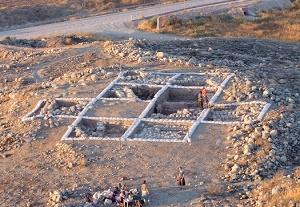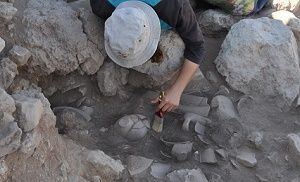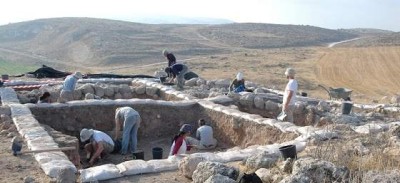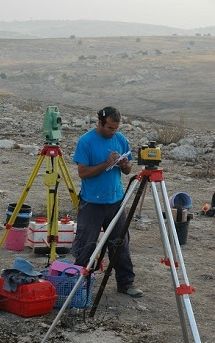
Op-ed
Digging Archaeology – A Report from the Trenches
Dr. Rabbi Zev Farber at the dig
I write this post from Israel, where I am currently on an archaeological dig for a few weeks. I have been part of this dig since 2011 (the dig itself began in 2006.) The dig is sponsored by Bar Ilan University and is being conducted by Prof. Avi Faust, with the assistance of Dr. Hayah Katz from the Open University.

We are excavating in an area called Tel Eton (see link for details), which we have reason to believe is biblical Eglon (Josh 10:3, 5, 23, 37, 12:12, 15, 39). The site is very large and a number of areas are being excavated simultaneously, each covering different periods of time. The area I am excavating is a massive eighth century BCE mansion, probably the governor’s mansion, which was destroyed by the Assyrian army of Sennacherib in 701.
The Indiana Jones Fallacy: Archaeology is not like Digging for Treasure
“What are you looking for?” This is the most common question that I get when I tell people that I participate in an archaeological dig as part of my summer work. It is difficult to answer this question since it holds within it a premise that archaeological digging is similar to treasure hunting. In treasure hunting, as we all know from books and movies, you start with a pirate map and it tells you where to dig; X marks the spot and underneath are the gold coins and jewels. Archaeology, in popular imagination, works the same way. Indiana Jones always has a specific artifact in mind, whether the Ark of the Covenant or the Holy Grail, and he has to search to find it. Real archaeology, however, doesn’t work this way.
What is Archaeology?
The goal of archaeology is to understand the past based on a study of its material culture. Broadly speaking, there are three kinds of archaeology (I am simplifying of course).
- There is survey archaeology, where people scout large swaths of territory and collect or note everything they find. This gives archaeologists a general sense of which periods of time a given area was occupied.
- There is excavation archaeology, where a site or part of a site is dug out in detail.
- There is laboratory archaeology, where various scientific tests are run on material from the dig site to determine its composition, where it comes from, how old it is, and many other things.
What we are doing on Tel Eton is excavation archaeology. A tel—a Hebrew word meaning “mound”—is a site that has multiple occupation layers one on top of the other. Usually tels are found in places that were attractive for people in antiquity to live in, whether because of easy water access, protection from enemies, good soil for farming, or other factors.

Before the tel is excavated, it is generally divided up into multiple areas (A, B, C, etc.), and each designated area into multiple squares (A1, A2, A3, etc). Each area gets a supervisor—mine is Aaron Greener—and the volunteers and other staff get assigned to a square (5×5 meters.)
The square itself may be subdivided—indeed it usually is—using features (like walls) that distinguish between two different parts of the square. Each of these subdivided squares are called loci. Loci are divided not only on a horizontal axis but also a vertical axis. Thus, when a new layer is reached, the locus number is changed to reflect that. Each time a locus is opened and closed measurements are taken to see how deep the digging has reached. All of this and more is recorded in the area supervisor’s log-book.
Why do I dig?
As I was studying to be a Bible scholar and a historian, I found it challenging to fully grasp and evaluate archaeological data without participating in an active way; this motivated me to join a dig and learn the discipline first hand. Archaeology is a kind of language and without really immersing in it, is hard to master. (This is the same reason I spent much of my time learning ancient language, but that is for a different post.) There are a growing group of Bible scholars who participate actively in archaeological digs.
A Day in the Life
So what does the average day of digging look like??
I wake up at 4:00am. I make a cup of coffee (a very large one) grab some of the dig equipment (the ones that cannot be left overnight at the tel) and water jugs and get on the bus. The bus leaves Kibbutz Kramim, where we are being hosted, at 4:40 (most people who wish to daven Shacharit do so during the breakfast break). We get to the tel around 5:15, grab some of the equipment and water jugs and walk up the dirt trails to the top of the tel and hopefully without tripping or getting winded. (I am usually successful with the former, never with the latter. The tel is rather high.)
Arriving at our square, Aaron Greener (the supervisor) and Michal Mermelstein (his assistant supervisor) take the measurements in all the loci that will be worked that day. While we put on our sunblock, hats and gloves, and work to put up the shade – a tarp that sits upon precariously balanced plastic pipes. Once everything is ready, we enter our loci and the work commences.
The day’s digging work is divided in three with two breaks. 8:15 is breakfast, 11:00 is fruit break. At 1:00 we go back to the kibbutz for lunch. After a few hours of break we wash pottery — the finds are cleaned (and we look at each piece carefully, hoping to find an ancient inscription, thought this is very rare), and the pottery is “read”– the archaeologists (Faust and Katz) look at the pottery and catalogue what kind there is and what period of time they are from. This can only be done by looking at rims, as their shape is indicative of the pottery type. The pottery is then bagged and shipped to a lab where some of it is reconstructed. Sometimes there are tours of other sites and lectures. After dinner (around 7:30) there is usually a staff meeting and then to bed for the next day’s early rise.
How We Dig
Depending on what is in each locus, different tools are used, but the basic tools we use are, pickaxes (large and small), hoes, trowels (square, round, and pointed), dustpans, brushes (hard and soft), buckets (black and colored) – lots of buckets!, a sledgehammer (for smashing boulders), sifters and wheelbarrows.
When the locus is filled with dirt and no feature can yet be discerned, the digging begins with pickaxes to loosen the dirt, which will be removed using wheelbarrows to a dumping area. Different archaeologists have their own policy on whether this dirt is sifted for findings.

Pottery sherds are put in a colored pottery bucket, but when an artifact is found, such as loom weights, worked bone, arrowheads, bullae (pieces of clay stamped with a seal), stamp-seals, etc., measurements are taken even before they are removed from the ground. The same is true for intact or complete vessels found in situ (i.e. the place where they were when they were used or smashed in antiquity.) Such vessels are also important because we can later (in the lab) take samples of the interior and do residue analysis to see what was in them.
Reaching New Layers and Structures
Once we arrive at something that feels solid, the digging method has to change. Since there is no way to tell if the stone or mud-brick we are hitting is part of a structure, part of a collapse, or just landfill we need to be careful as we dig around it and try to expose it. Here we switch to the mini-pickaxe for breaking up the dirt in a controlled manner.
As the possible features are exposed, we take the rough brush and begin to clean the stones or bricks and the dirt area near it to see clearly. If it is determined that the rocks or bricks make a wall, the area is split in three. Each side of the wall becomes a locus and the wall itself is listed as a feature.
Floors are particularly hard to determine since in ancient times, they were made of packed dirt. To identify a layer we need to look for color changes and the feeling of “packedness” in the soil. This latter skill takes practice and new diggers tend to call their area supervisor many times asking whether what they just found is the floor or not. (This is better than the alternative, where someone accidentally destroys the floor before the supervisor can see it.)
Every time a layer or feature is identified, it is catalogued with pictures. To get good pictures, there needs to be serious cleaning – a job that is harder than it sounds. All the loose dirt needs to be removed from the locus and the feature needs to be brushed clean. At the end of the season, the entire dig spends days cleaning and pictures are taken from the sky with a camera attached to a hot air balloon or a drone. In addition to the pictures, all of the walls will be traced in a computer program (we use the Total Station.)
The Critical Balk

One critical part of modern digging is the balk: the area between squares that is not excavated. These are the areas covered in sandbags that one can see in pictures of most archaeological sites. The sandbags are placed on the balks so that they can be easily distinguished in photographs and not be mistaken for walls or other original features.
The function of these balks is so that as the square is dug down, the archaeologist can see the layers that have been dug through by looking at the material in the different layers of the balk. The area between the top of the balk and the bottom of the square is called a section. Leaving the sections intact gives archaeologists another opportunity to look over what was in the square from a different perspective and see if anything may have been misinterpreted or overlooked. These sections are recorded not only or even primarily in pictures but with hand drawings. The drawings are not impressionistic but based on exact measurements taken by the artist. At the end of the season, these sections together with whatever features/architecture was found in the area will be studied to try to make sense of the relationships between the various features, whether physical relationship (i.e. are they part of one structure) or temporal relationship (which came first, etc.). This study is called “phasing.”
When the dig season is finished, the area will be closed up with barbed wire until the next season, to ensure no one falls into any of the deep pits being dug, and the artifacts and pottery together with the logbooks will be sent back to the university for study.
Precision, Precision, Precision

Why is it important to be so precise? This is the rub when it comes to archaeology. In order to find things and study them you have to destroy them. Thus, if everything is not recorded precisely, the archaeological situation of the site will be impossible to recreate. Even worse, no other archaeologist will ever be able to evaluate your work or rethink your conclusions since the site cannot be excavated again. Thus the pictures must be of excellent quality (hence the cleaning), the sections must be drawn, the buckets must be counted (to determine the volume of the digging) and measurements must be taken multiple times daily.
Let me illustrate this problem with an example from my site. I dig in Area A. We are digging out a massive eighth century building, probably the governor’s mansion. The building is fascinating and chock full of finds. This is because the building was destroyed—probably by Sennacherib in 701 BCE—thus leaving all of it contents in situ, and we must remove these contents in the process of digging. This is the sad irony of archaeology. Destruction is terrible for the inhabitants, all of whom were either killed or forced to flee their homes, but perfect for archaeologists. Digging out a home that was abandoned yields significantly less finds, since the inhabitants take things with them.
The building we are digging was not on the top of the tel, however. On top of this building were the foundations of a giant fortress, probably from the Persian period. Although this was not the focus of the dig, the fortress needed to be cleaned and fully excavated, photographed and documented. Having done this, the fortress had to be removed stone by stone. There is no way to dig directly under something without removing it. Excavation on a tel by its nature involves destruction of what it studies. Since all studies of the Persian fortress now and in the future can only base itself on our excavations (after all we removed it), it is critical that we are as precise as possible and record as many details as possible.
In short, accuracy and thoroughness is all that divides between an archaeological dig and treasure hunting. The former is hard work, but done properly the amount we can learn about our past is truly dazzling.
TheTorah.com is a 501(c)(3) nonprofit organization.
We rely on the support of readers like you. Please support us.
Footnotes

Dr. Rabbi Zev Farber is the Senior Editor of TheTorah.com, and a Research Fellow at the Shalom Hartman Institute's Kogod Center. He holds a Ph.D. from Emory University in Jewish Religious Cultures and Hebrew Bible, an M.A. from Hebrew University in Jewish History (biblical period), as well as ordination (yoreh yoreh) and advanced ordination (yadin yadin) from Yeshivat Chovevei Torah (YCT) Rabbinical School. He is the author of Images of Joshua in the Bible and their Reception (De Gruyter 2016) and editor (with Jacob L. Wright) of Archaeology and History of Eighth Century Judah (SBL 2018).


